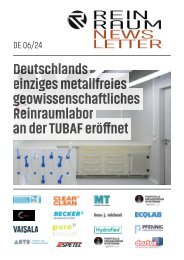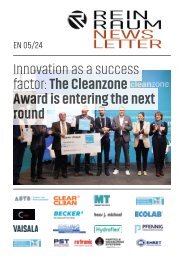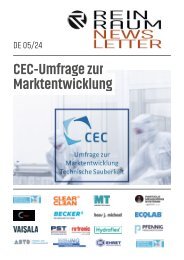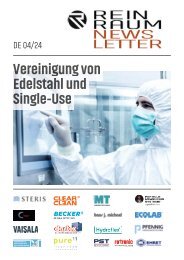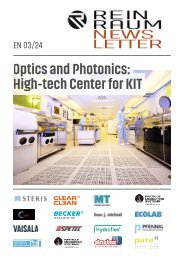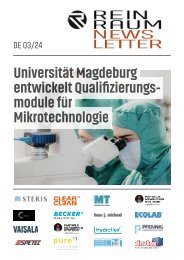Newsletter_07-2024_EN
Create successful ePaper yourself
Turn your PDF publications into a flip-book with our unique Google optimized e-Paper software.
In particular, many companies, switching to under-isolator<br />
production, are considering the use of concentrated products for<br />
Grade C/D outdoor environments. Would you recommend their<br />
use? If so, with which procedure?<br />
Yes, there are no concerns, especially within lower grades of cleanrooms.<br />
The important point is to ensure the dilution is correct and<br />
that the correct grade of water is used.<br />
Training of personnel<br />
Personnel training: with the latest Annex 1, and the increasingly<br />
stringent rules on cleaning and disinfection, personnel training is<br />
a key point. Are there also changes in training methods with the<br />
new Annex 1?<br />
The Annex could go further with training. Appropriate training for all<br />
personnel dealing with disinfectants is vital. This training should include<br />
all relevant staff including contract personnel working within<br />
the facility. Documentation of this training is essential. All personnel<br />
should understand the importance of cGMP. For a new employee,<br />
this training could be part of their initial GMP induction. A pre-determined<br />
program of training should be in place and documented as<br />
well as a system to measure the effectiveness of the training. Personnel<br />
should all be trained in good cleaning techniques using the appropriate<br />
equipment. All staff should be provided with appropriate<br />
clothing in order to perform this operation, e.g., cleanroom clothing<br />
in manufacturing areas with adequate PPE. Procedures should also<br />
be in place if spillage occurs with any of these agents.<br />
Training programs could include:<br />
– The importance of disinfection in relation to GMP, its necessity<br />
in preventing microbial proliferation, cross contamination and<br />
the importance and significance of good disinfection routines.<br />
– The importance of the correct handling of disinfectants, whether<br />
it is during the disinfectant’s preparation, testing or use.<br />
– Basic microbiology and how contamination is transferred in the<br />
workplace.<br />
– An understanding of the properties of disinfectants and their<br />
correct application.<br />
A refresher program should also be in place, ensuring that once personnel<br />
are trained, their knowledge is kept up to date. Many companies<br />
now incorporate this into regular GMP refresher training,<br />
recommended to be undertaken on a periodic basis. Adequate documentation<br />
of these updates in an employee training record is essential.<br />
Cleaning & Disinfection in Grade C & D areas<br />
Finally, the CCS in the new Annex 1 extends to all areas at risk of<br />
contamination.<br />
Also in paragraph 4.35 it is stated that “disinfectants used in grade<br />
C and D may also be required to be sterile where determined in the<br />
CCS”. This implies increased attention also for non-sterile areas<br />
and for producers of cosmetics, ointments and biological intermediates<br />
with low bacterial load etc. For the latter, the challenge will<br />
certainly be significant. What are the essential activities to adapt?<br />
Some good practices for the adoption and use of disinfectants, in<br />
accordance with GMP, are:<br />
– Written procedures should be in place.<br />
– Responsibilities for cleaning should be assigned. Often this is interpreted<br />
as the need to have independent cleaning staff separate<br />
from those involved in product manufacture.<br />
– Staff must be trained in cleaning techniques and have a training<br />
record.<br />
– Details of cleaning frequencies, methods, equipment, and<br />
materials must be recorded in written procedures. This may<br />
relate to an approved supplier specification.<br />
– The cleaning of equipment and materials must take place<br />
at regular intervals.<br />
– Inspection of equipment for cleanliness before use should<br />
be part of routine operations.<br />
– A cleaning log should be kept. The purpose is to keep a record of<br />
the areas cleaned, agents used, and the identity of the operator.<br />
– The microorganisms isolated (the microbiota) from environmental<br />
monitoring programs should be examined for resistant strains.<br />
Some isolates from these reviews should be incorporated into<br />
disinfectant efficacy studies.<br />
– The monitoring for microbial contamination in disinfectant and<br />
detergent solutions should be periodically undertaken.<br />
– The storing of disinfectant and detergent solutions should be for<br />
defined (and short) periods.<br />
– Room use should be recorded after each operation.<br />
– There should be a technical agreement with the company who<br />
supplies the disinfectant. Ideally the disinfectants purchased<br />
should be lot tracked.<br />
– SOPs containing references to disinfectants, cleaning agents,<br />
materials and equipment used and calibration of equipment<br />
are accessible. Here the cleaning and disinfection methods are<br />
clearly defined.<br />
– The SOP should include cleaning method details e.g., wiping<br />
front to back or top to bottom with overlapping strokes.<br />
– Cleaning method, e.g., double bucket, rinsing wipe action, contact<br />
time and cleaning of cleaning materials must also be included in<br />
the<br />
– Documentation of rotation, rationale, and frequency,<br />
needs to be set out.<br />
– Cleaning logs also need to be in place and available.<br />
In compliance with GMP, cleaning and disinfection procedures<br />
should be included in any audit program as it maintains assurance<br />
that contamination control procedures are adequate and in control.<br />
Conclusions<br />
The Contamination Control Strategy underlying the new Annex 1<br />
finds its backbone in Quality Risk Management: assessing risks on a<br />
scientific basis and offering a commensurate response to them is the<br />
real key to adapting to the new requirements.<br />
Dr. Tim Sandle is a pharmaceutical microbiologist, science writer and<br />
journalist. He is a chartered biologist and holds a first class honours<br />
degree in Applied Biology; a Masters degree in education; and has a<br />
doctorate from Keele University.<br />
AM INSTRUM<strong>EN</strong>TS<br />
Via Isonzo, 1/C<br />
Phone: +39 02 8728421<br />
email: info@aminstruments.com<br />
IT20812 Limbiate (MB)<br />
Internet: https://global.aminstruments.com/<br />
www.reinraum.de | www.cleanroom-online.com NEWSLETTER | Edition <strong>EN</strong> <strong>07</strong>-<strong>2024</strong><br />
page 6/28








